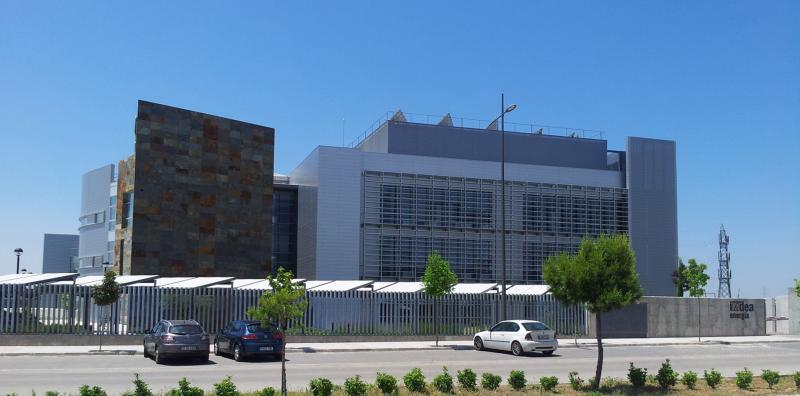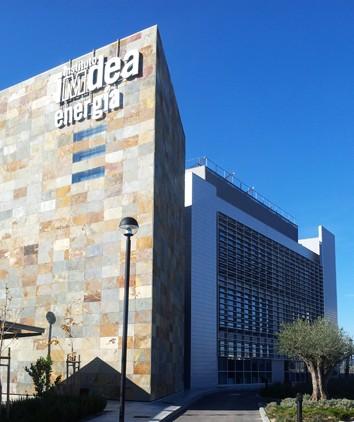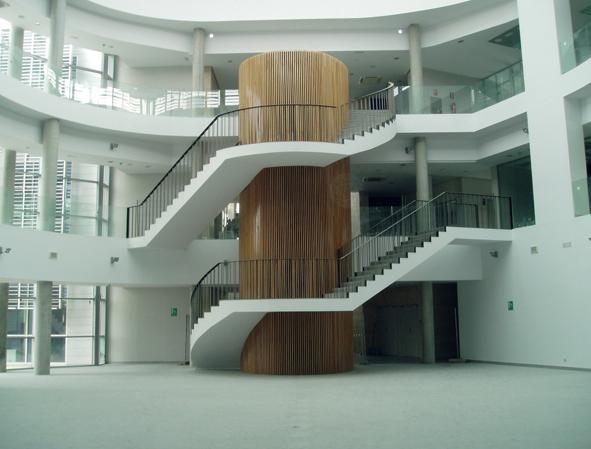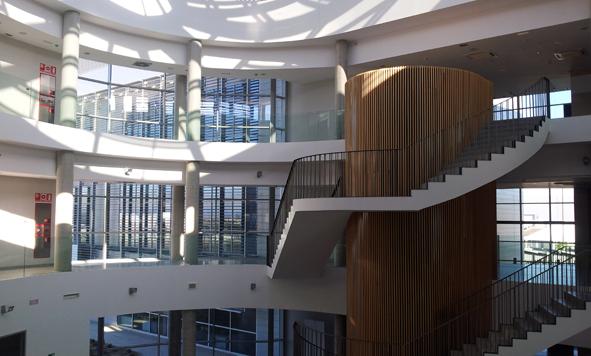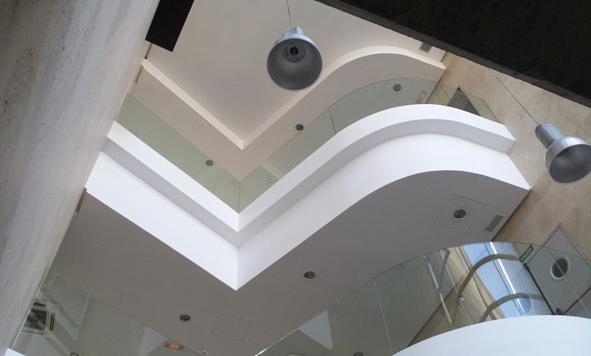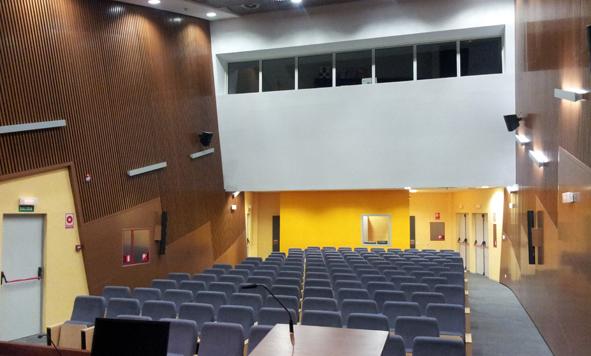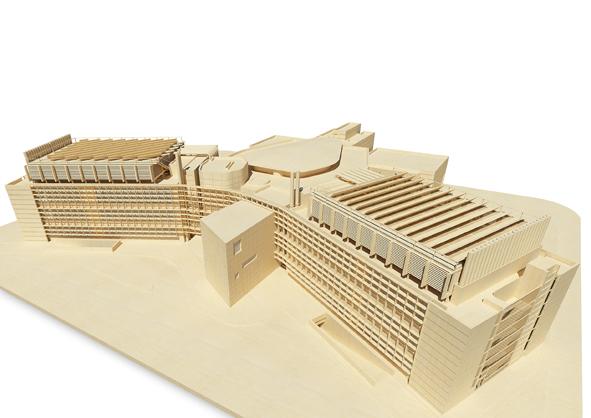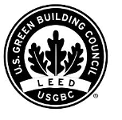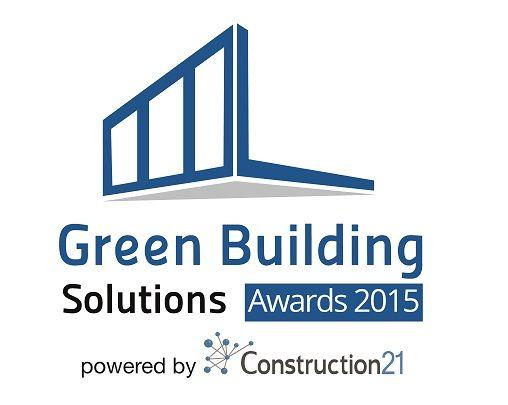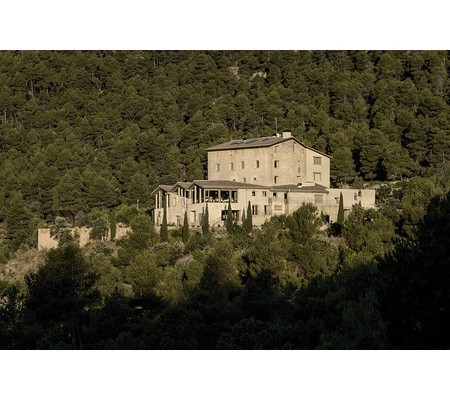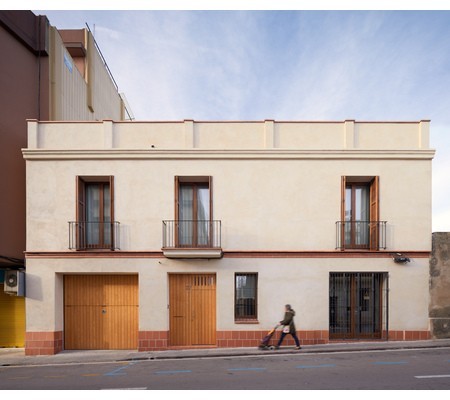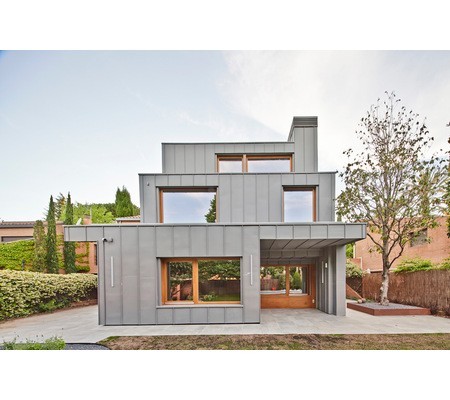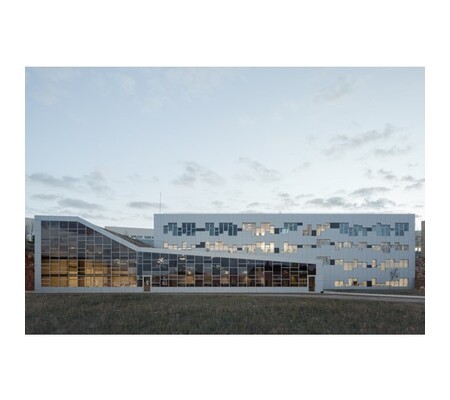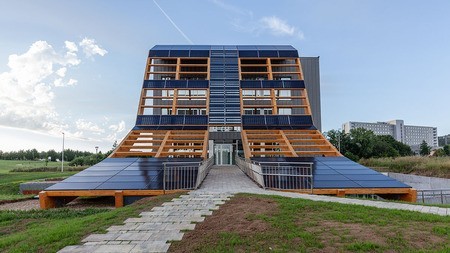Madrid Institute for Advanced Studies (IMDEA)
New Construction
- Building Type : Office building < 28m
- Construction Year : 2012
- Delivery year :
- Address 1 - street : AVENIDA RAMÓN DE LA SAGRA, 3, PARQUE TECNOLÓGICO DE MÓSTOLES. 28933 MÓSTOLES, España
- Climate zone : [Csa] Interior Mediterranean - Mild with dry, hot summer.
- Net Floor Area : 6 957 m2
- Construction/refurbishment cost : 9 270 724 €
- Number of Work station : 471 Work station
- Cost/m2 : 1332.57 €/m2
Certifications :
-
Primary energy need
168.9 kWhpe/m2.year
(Calculation method : RD: 47/2007 )
The Madrid Institute for Advanced Studies (IMDEA) was created on the initiative of the Regional Government of Madrid with the aim of promoting and carrying out R&D activities related to energy, with special emphasis on renewable energies and clean energy technologies. A modular building was designed around a three storey NUCLEUS, with an open space in the middle, used as an entrance hall and reception area, which also contains the administration, management and relaxation areas. Around it, the MODULES are juxtaposed in radial form, containing the different research divisions. Technical rooms, fitted with the latest technology to generate clean and renewable energies as well as providing protection against excessive sun radiation, are placed on the roof of each module. The IMDEA ENERGY building was designed and developed according to the Green Building specifications, established by the US Green Building Council) targeting the highest LEED Certification. It obtained the Gold Certification (LEED NC2.2 Gold)
See more details about this project
http://www.usgbc.org/projects/edificio-fundacion-imdea-energiaData reliability
3rd part certified
Stakeholders
Designer
ARKITOOLS. Luis García Gil. Félix Garrido Morán y Jaime García Rodríguez, arquitectos
Jaime García. [email protected] Madrid
https://es-es.facebook.com/pages/Arkitools/171097592990275Developer
INSTITUTO IMDEA ENERGÍA
http://www.energia.imdea.org/Construction company
OFINCO
http://www.ofinco.com/Construction company
INITEC
Construction Manager
SACYR
http://www.sacyr.com/syv/Door.do?OPERATION=portalGrupo&FUNCTION=8&locale=esStructures calculist
HCA
Juan Antonio Domínguez
Contracting method
Other methods
Owner approach of sustainability
In 2007, the Urban Consortium of Mostoles Technology launched a Public Tender for the elaboration of a draft for the building of the Madrid Institute for Advanced Studies in Energy (IMDEA Energy) in the sector Pau-5 “Mostoles Technology”. We were the winner of this tender and as a result we elaborated the design of the project. The Madrid Institute for Advanced Studies in Energy was created on the initiative of the Regional Government of Madrid with the finality of promoting and realizing R&D activities related to energy, with a special focus on questions related to renewable energy and clean energy technologies. The building for the Madrid Institute for Advanced Studies in Energy (IMDEA ENERGIA) was conceived based on three conceptual proposals. It was decided to develop one of them on the land that was donated to the city of Mostoles, within the future “Mostoles Technology” park (Sector PAU-5). The final proposal was developed in close collaboration with the client, based on an environmental, energy and economic sensitivity approach. This culminated in a proposal designed to have a building able to operate for a long time, under changing conditions. These conditions could result from technological and social progress or changes in the current or future investigation being carried out by this Institute. All this without neglecting the particular character of this building representative of the research and development that takes place within it. It is also conceived under strict efficient economic parameters, essential for the durability and sustainability of the building. The project was a challenge for both the designers and the developers. We were faced with the design of a building that had to be energy efficient during its construction and its operation, as well as being economically and technically viable, but at the same time keeping in mind the purpose for which it was intended.
Architectural description
A modular building was conceived which could be expanded or divided without affecting its functionality or image. It was developed around a CORE on three levels, with an open space in the middle, used as an entrance hall and reception area and which houses the common administration, management and relaxation areas. This space favors and promotes interaction between the users, as a transit and meeting area, alma mater and heart of the building, both functional and symbolic. Restoring the house courtyard typology inside this space, covered by a large skylight, created a microclimate through the regulation of sunlight, ventilation and humidity. Around this central module, on all three floors, are coupled or juxtaposed in radial form MODULES harboring the research areas. These were conceived as containers free of vertical structure. This facilitates distribution or subdivision, which is more convenient in its long term use. On the roof of these modules, are placed technical rooms equipped with the technology needed for the generation of clean and renewable energy. In addition they provide a passive defense cover against excessive solar radiation. At the end of the plot and on both sides of the planned core service area in the building, the PILOT WORKSHOPS are located. These are used to set up experimental equipment or as annexes necessary for the development of planned activities. Special care has been taken when orienting the building, treating the different facades according to their function and orientation, looking for the best energy efficiency, seeking to integrate the summary of all renewable energies, by applying the criteria of bioclimatic architecture so that resources are optimized and energy losses are minimized. SUSTAINABILITY The IMDEA ENERGY building is designed and planned taking into account the premises of a Green Building, seeking maximum ENERGY RATING ("A") and fulfilling the requirements of a certification system for sustainable buildings. By selecting the LEED certificate developed by the Green Building Council in the United States (U.S. Green Building Council), obtaining a gold certification (LEED NC 2.2 gold). -In areas exposed to direct sunlight, the building has white “Emugrava” covered with SRI (Solar Reflection Index) greater than 78, to reduce the heat island effect. -The distribution and separation of space between classrooms, laboratories and offices is created by glass screens, which allow great flexibility, and better natural lighting and visibility, both from the inside and from the outside of each enclosure. -In the construction of the building, a high percentage of recycled materials have been used, such as steel, aluminum or glass. -Materials such as natural stone have also been used. For the concrete and ceramic materials, priority has been given to regional raw materials or local manufacturing. -The materials derived from wood are defined by the FOREST STEWARDSHIP COUNCIL (FSC) certificate.
Energy consumption
- 168,90 kWhpe/m2.year
- 491,70 kWhpe/m2.year
Envelope performance
- 0,39 W.m-2.K-1
Systems
- Geothermal heat pump
- Low temperature floor heating
- VAV System
- Individual electric boiler
- Solar Thermal
- Reversible heat pump
- Geothermal heat pump
- VRV Syst. (Variable refrigerant Volume)
- Free-cooling
- compensated Air Handling Unit
- Solar photovoltaic
- Solar Thermal
- Heat Pump on geothermal probes
Smart Building
Life Cycle Analysis
Water management
Product
Panel 231 is a rigid stone wool slab
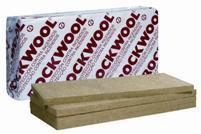
rockwool
http://www.rockwool.es/Acabados / Acabado, aislamiento
Thermal and acoustic insulation of technical equipment such as reservoirs, boilers, ovens, reactors...The panels are fixed on flat or low curve radius walls. It is widely used in offshore and marine building.
1- Excellent thermal and acoustic insulation as well as being highly fire retardant.
2- Resistant to high temperatures.
3- Non absorbent
4- Easy to install
5- Chemically inert
6- Free of CFC and HCFC, respecting the environment
Calibel
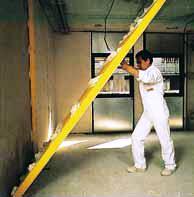
isover
http://www.isover.es/Acabados / Acabado, aislamiento
Two component insulating panels (rigid glass wood insulating panel with plasterboard).
1- Direct solution without masonry
2- Excellent product for renovations
3- Totally stable material
4- Easy and fast installation
5- Rot-proof and odourless
6- Micro-organism free
7- Non absorbent
8- Does not require maintenance
9- Energy efficient
Thermal conductivity/ ≤ 0,034 W / (m• K)
Fixed large Louvre Blades Schuco ALB

schueco
http://www.schueco.com/Acabados / Carpintería exterior - Puertas y Ventanas
The fixed large louvre blade system offers effective solar shading without impairing the view in any way. Whether daylight control or shading, manual or automatic control – with large blades, façade and solar shading melt into one to form a single harmonious unit.
The wide choice of profile systems and the large number of fixing options allow almost any design requirement to be realised.
Type of blades used:
1- PH (Passive, Hollow Blade): Hollow blades with elliptic design from 105 to 470mm.
2- PM (Passive, Metal Blade): Blades with elliptic design from 470 to 690mm.
Photovoltaic panels CS6P
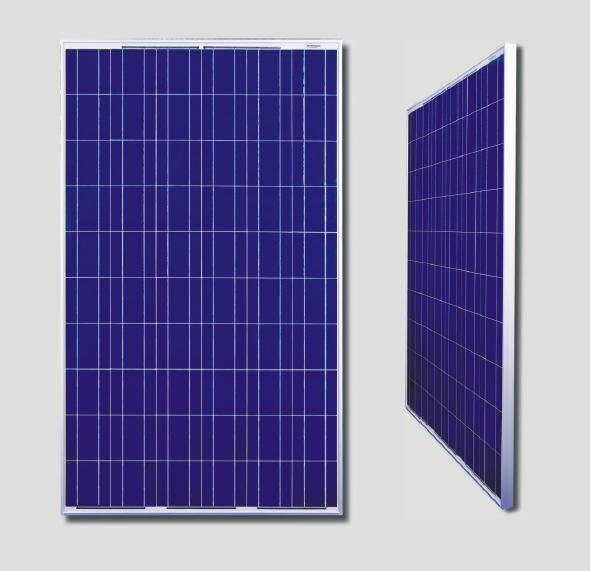
Canadian Solar
http://www.canadiansolar.com/
CS6P is a high end photovoltaic panel with 60 High-Efficiency Polycrystalline Solar Cells. A meticulous design along with high production quality control guarantees a maximum power output.
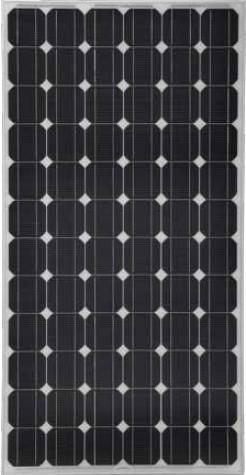
Fire Energy
Tel. +34 91 879 88 52
http://www.fire-energy.net/
Urban environment
More than 50% of the total project area has been restored through a remodelling of the grounds and planting of open green spaces, using indigenous or suitable vegetation. Over 40% is now a landscaped area.
Land plot area
10 000,00 m2
Built-up area
27,00 %
Green space
1 380,00
Parking spaces
In the parking lot, spaces have been reserved for efficient and low emission vehicles as well as for car-pooling. The surface of the car park is permeable.




